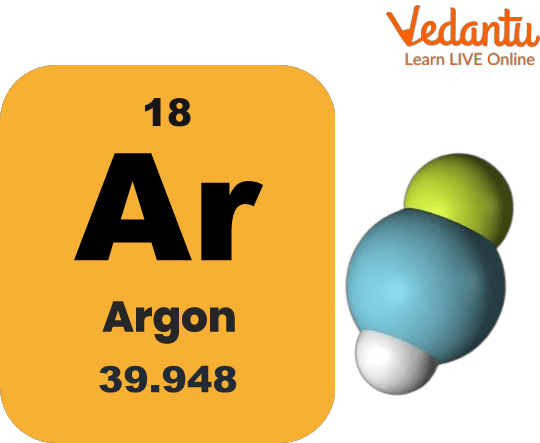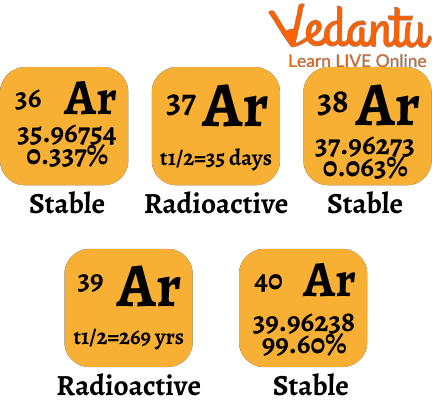




Why Is Argon Important in Everyday Life?
Today we will talk about an essential element: Argon. So, first, let us understand what is Argon. Argon is a chemical element. The symbol of Argon is Ar. The argon atomic number is 18. It is a noble gas. It is the third most abundant element on the earth. It is a colourless gas. Argon is an electrical insulator. Industrially it is more effective. It was isolated from the air in 1894 by the British scientist Lord Rayleigh and Sir William Ramsay. It is present in the eighteenth column of the periodic table.
In this article, we are going to learn where argon can be found, the uses of argon and the atomic weight of argon. So, let us start learning about this amazing element argon.

Argon
Chemical Properties of Argon
The chemical properties of argon are as follows:
Symbol of Argon: Ar
Argon Atomic Number: 18
Atomic Weight of Argon: 39.948
Classification of Argon: Noble gas
Phase at Room Temperature: Gas
The Density of Argon: 1.784 g/L at 0°C
Melting Point of Argon: -189.35°C, -308.83°F
Boiling Point of Argon: -185.85°C, -302.53°F
Physical Properties of Argon
The physical properties of Argon are as follows:
It is a colourless, odourless gas.
It is an inert gas.
Argon can form some compounds under certain conditions.
It has the same solubility power as oxygen.
It shows low thermal conductivity.
Where Argon can be found?
Argon is the third most abundant element on earth after nitrogen. It comprises 1% of the volume of air. It is the most abundant noble gas. Argon is present in the earth’s crust and ocean water in some amount. It is also formed from liquid air as a byproduct of the production of oxygen and nitrogen. The amount of Argon has been increased as radioactive potassium-40 converts into argon as it decays.
Uses of Argon
The uses of argon are as follows:
Argon is used in metal industries.
Argon is used in the production of titanium.
Argon is used to fill the space between panels in the double dazzled window.
Argon is used in the welding industry.
Argon lasers are helpful in the treatment of retinal detachment.
Agon is used in lightning in neon tubes.
Argon is used to displace air in food and drinks.
Argon is used in the preservation of old documents.
Argon is used in home fixers.
Argon is used in scuba diving suits.
Argon is used in providing a blanket atmosphere for the growth of crystals.

Argon
Isotopes of Argon
Argon has three isotopes argon-36, argon-30, and argon-40. These all are stable isotopes of argon. Argon-40 is the isotope of argon that is found naturally on earth. The most common isotope is argon-36.

Isotopes of Argon
Facts About Argon
The facts about argon are as follows:
Argon is a flavourless gas.
Argon was the first discovered noble gas.
The name argon was derived from the Greek word Argos which means inactive.
Most of the argon is discovered from the radioactive decay of potassium-40.
The most abundant isotope of argon is argon-36.
Argon is one of the most abundant noble gases.
Liquid argon is useful in cryosurgery.
Summary
Argon is a colourless, odourless, flavourless noble gas. It is found in a huge quantity. Argon is the element with the symbol Ar and has an atomic number of 18. It has good solubility power. It is found in the earth's crust as well as in oceans. It is the first noble gas. It has three isotopes argon-36, argon-30, and argon-40.
Argon is used for many different purposes, like laser surgery, plasma balls, light bulbs, rocket propellant, and glow tubes. Argon gas has no biological function. In this article, we have discussed the uses of argon and the atomic weight of argon.
FAQs on Interesting Facts About Argon for Students
1. What colour does argon glow?
Argon glows and provides different colours when it is electrified. It can be mixed with other different elements to form new colours. Currently, it can produce 150 colours. Argon gives a blue colour when glows with the neon.
2. Can humans breathe argon?
Argon gas is not good for humans when inhaled. If inhaled in an excessive amount, it will cause nausea, dizziness, vomiting, loss of consciousness, and even death in the worst conditions.
3. What does argon gas do to your voice?
The argon gas does not change the rate of vibration of human vocal cords.
4. What happens when mercury is added to argon gas?
If a small amount of mercury is added to argon gas it will glow to give a blue colour. Argon emits blue-green colour when used as a gas laser.









